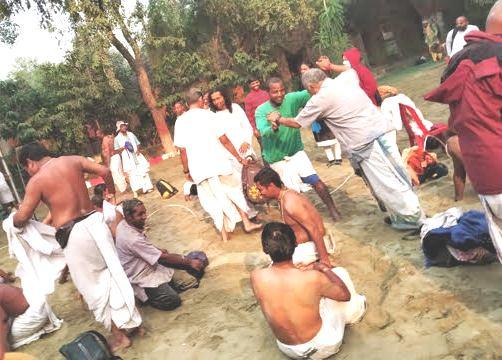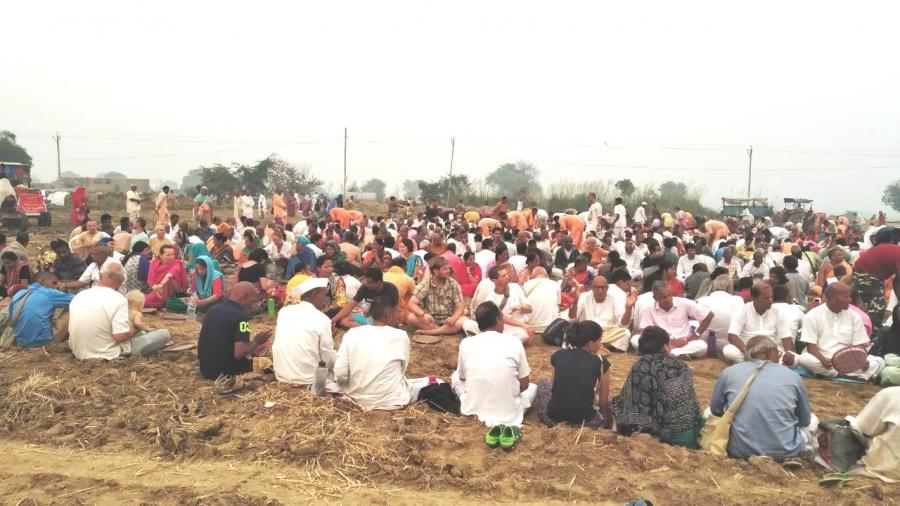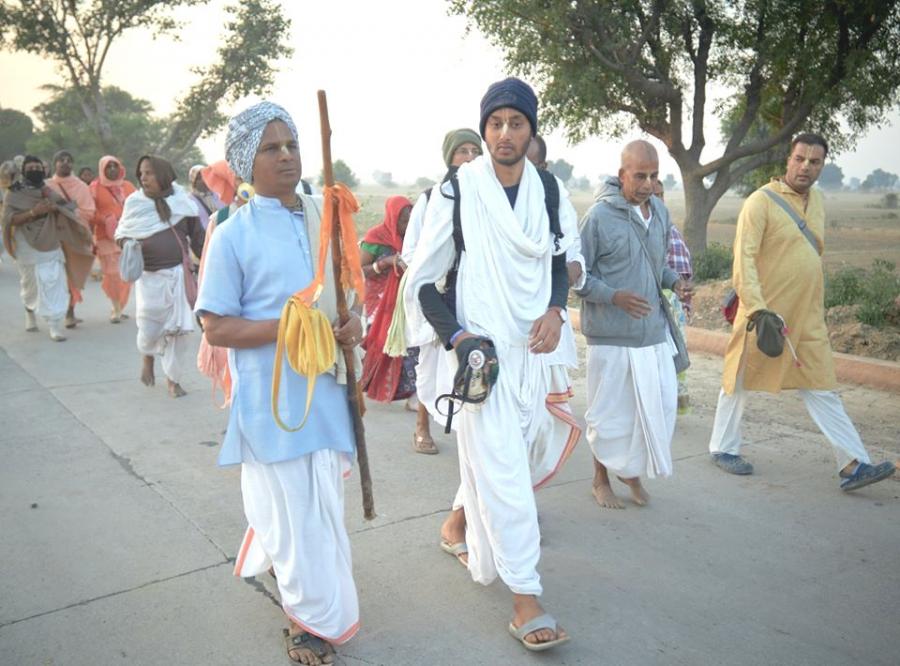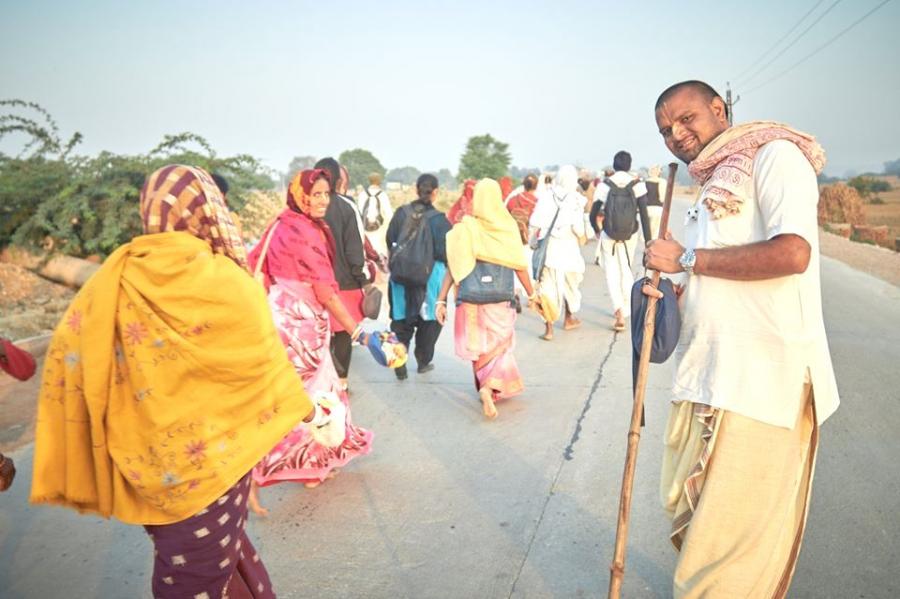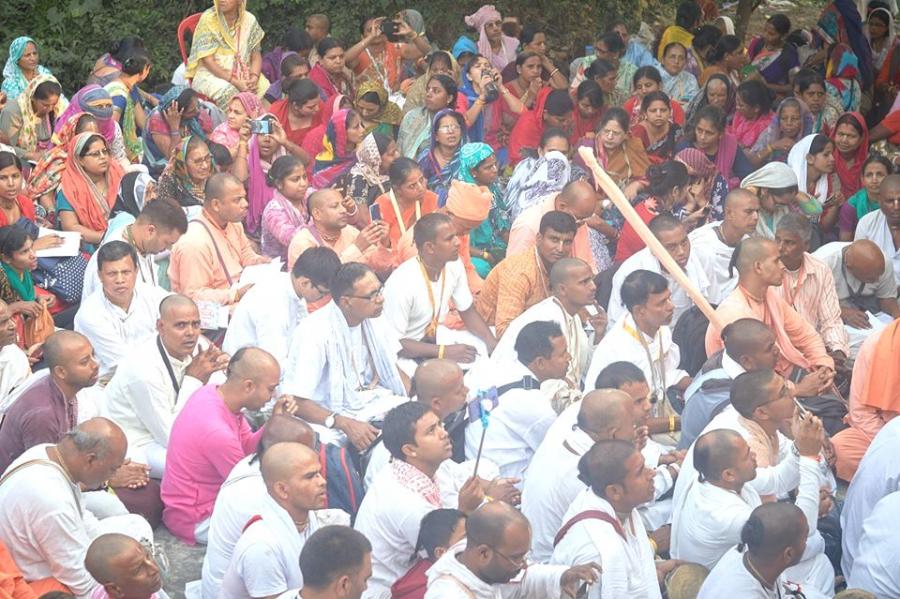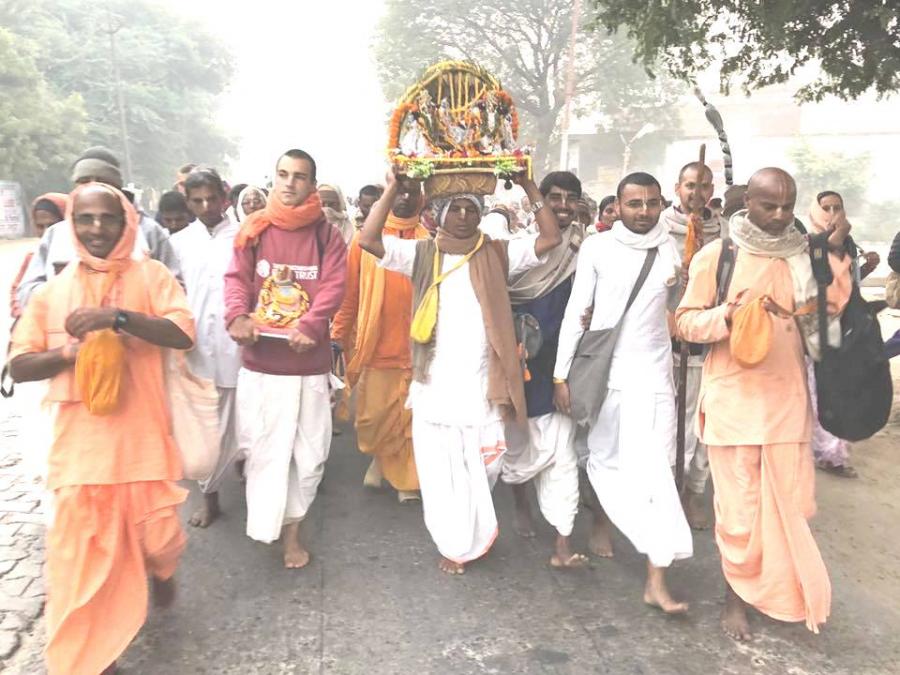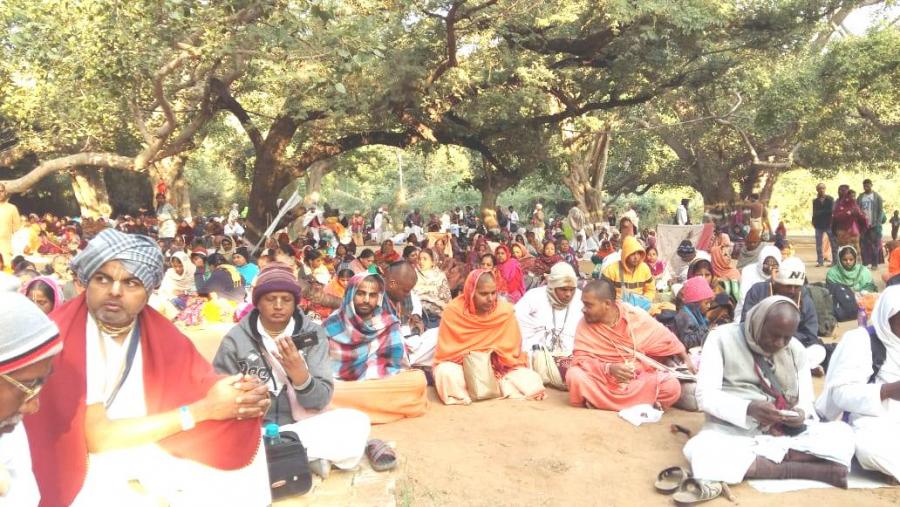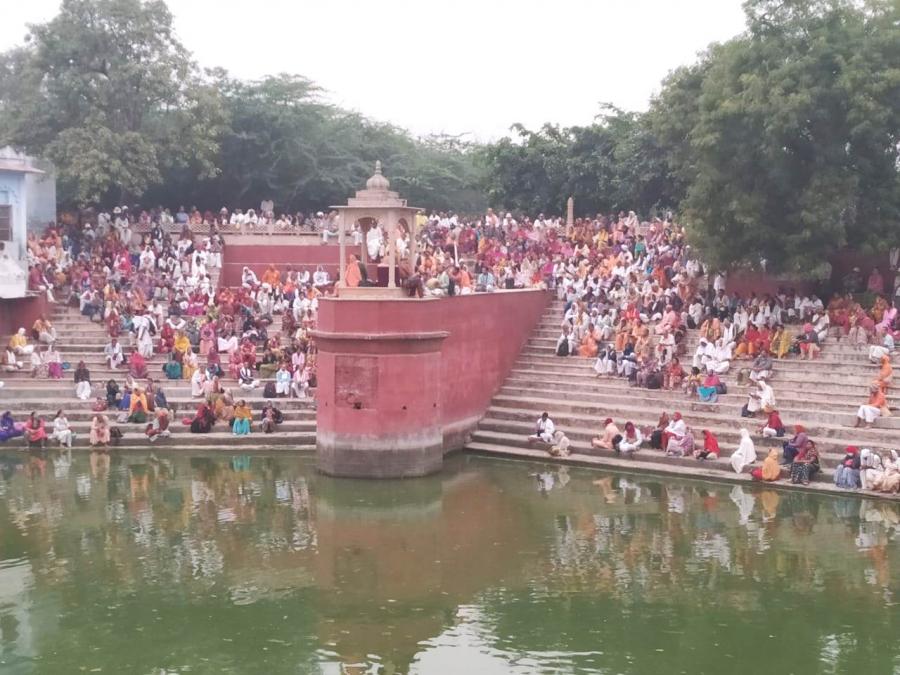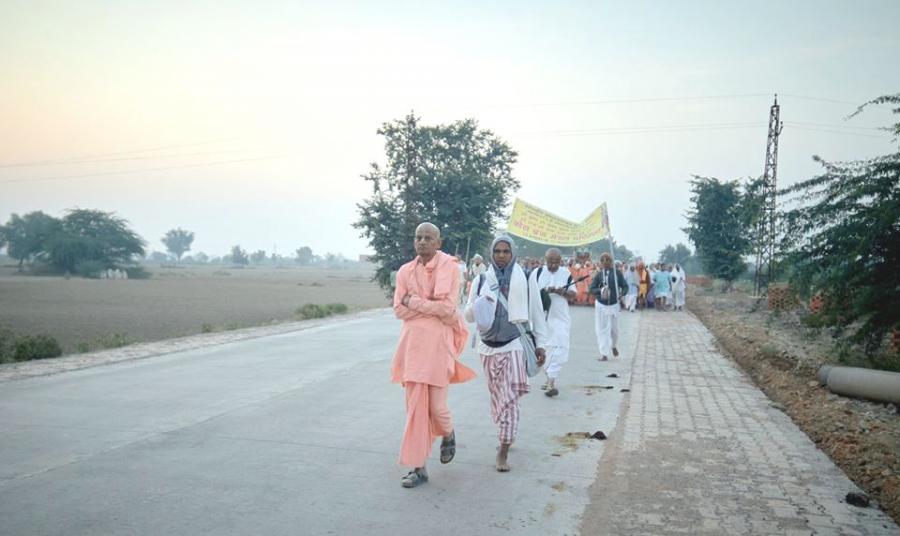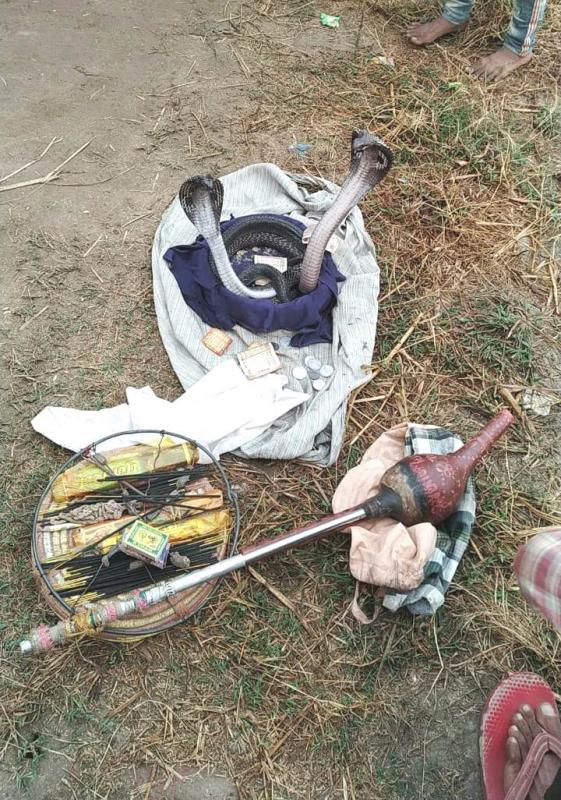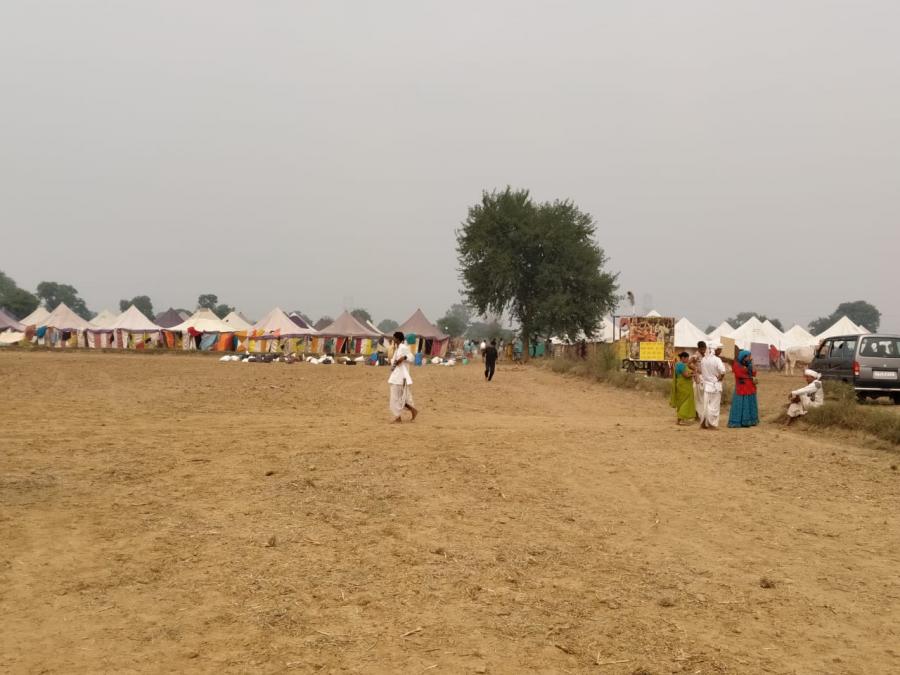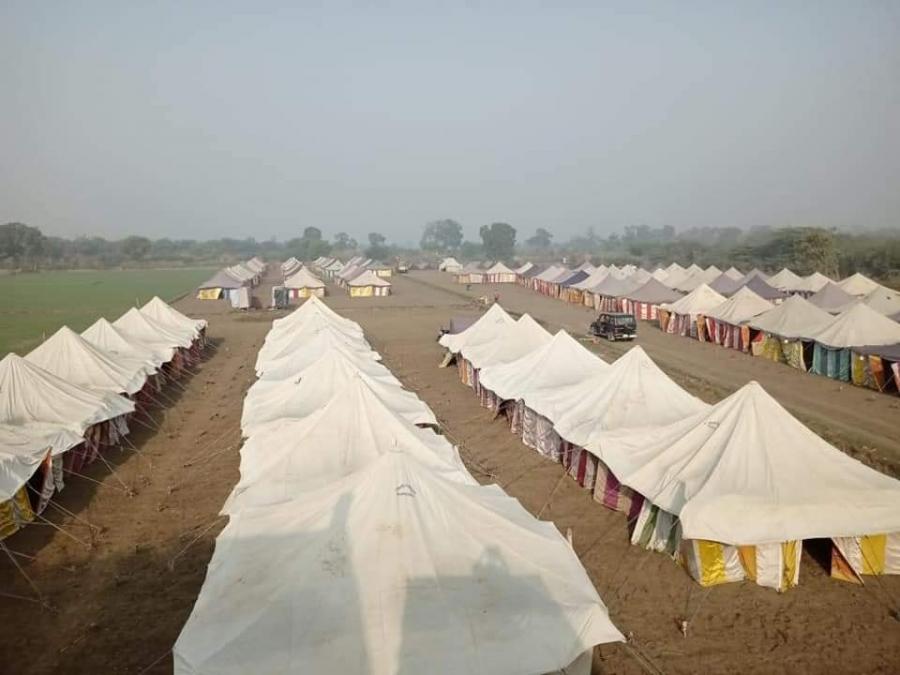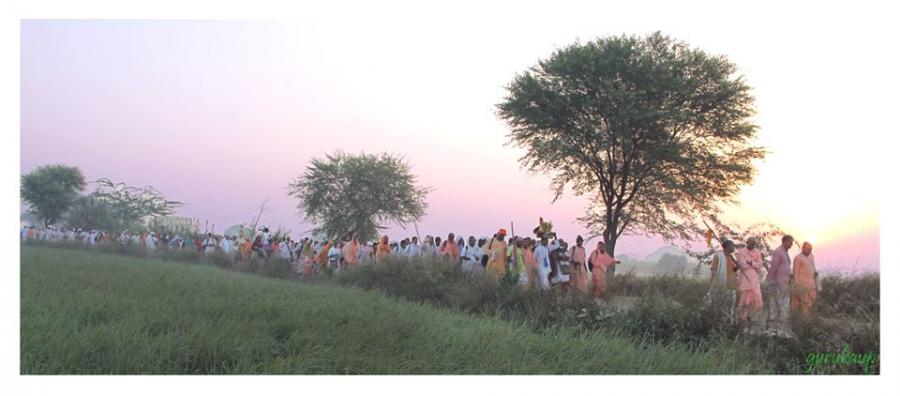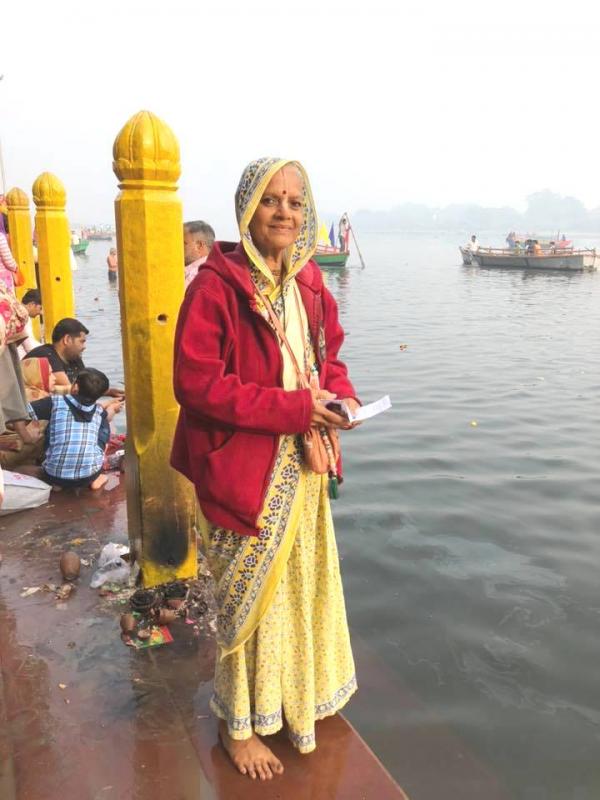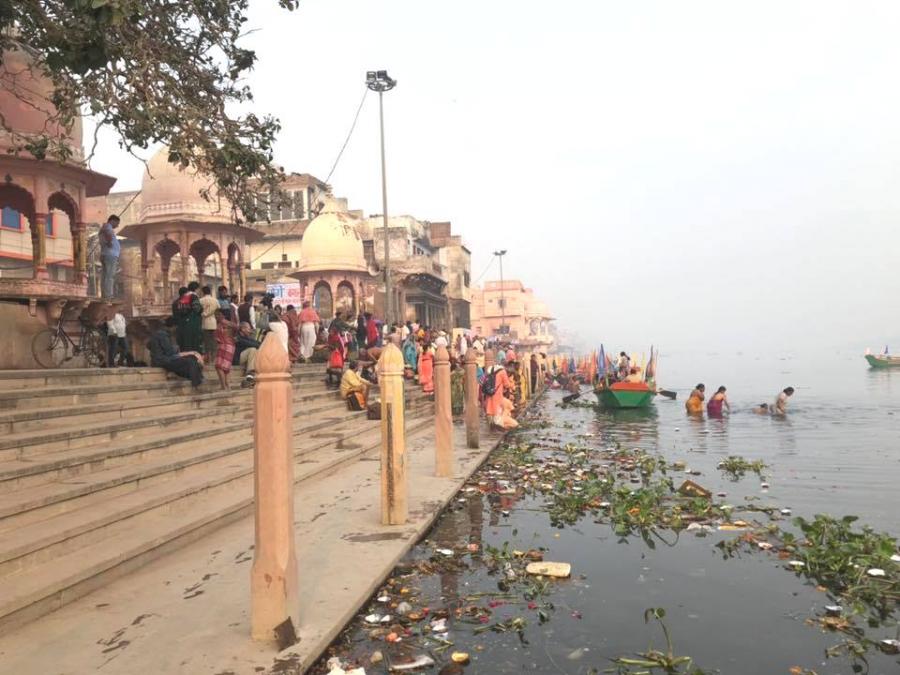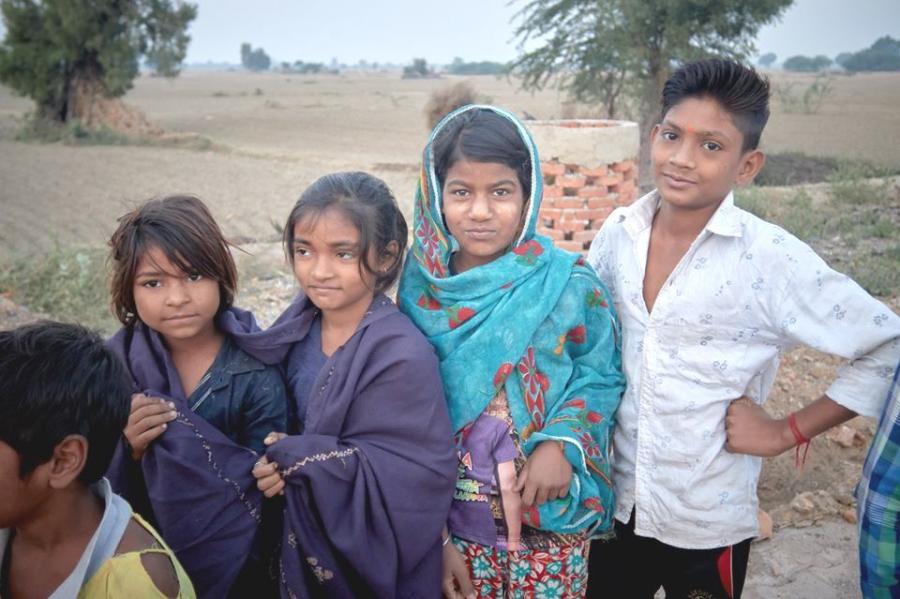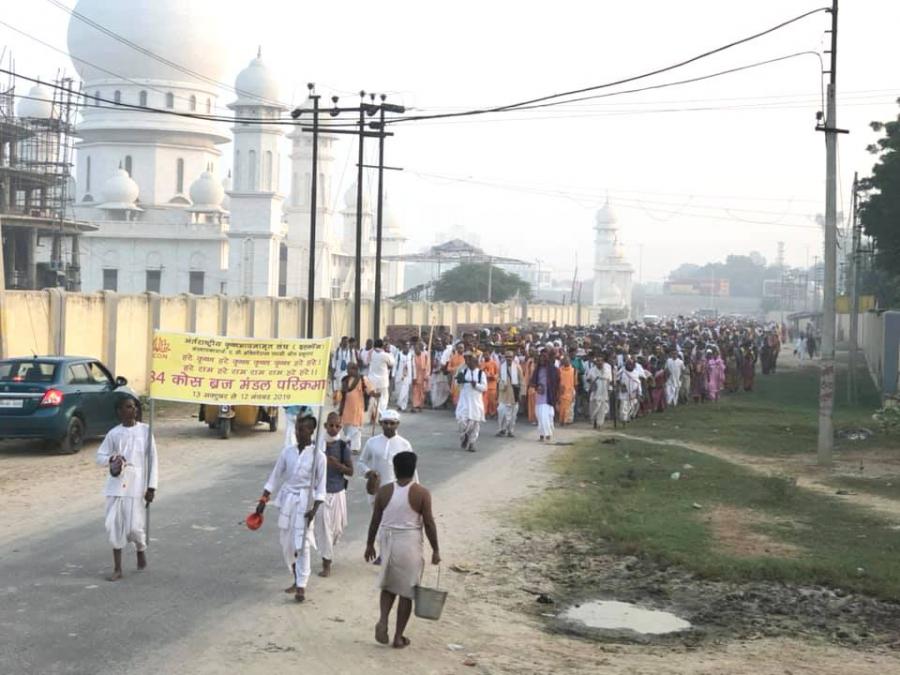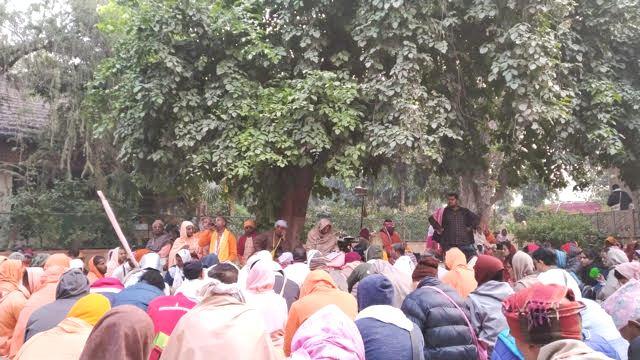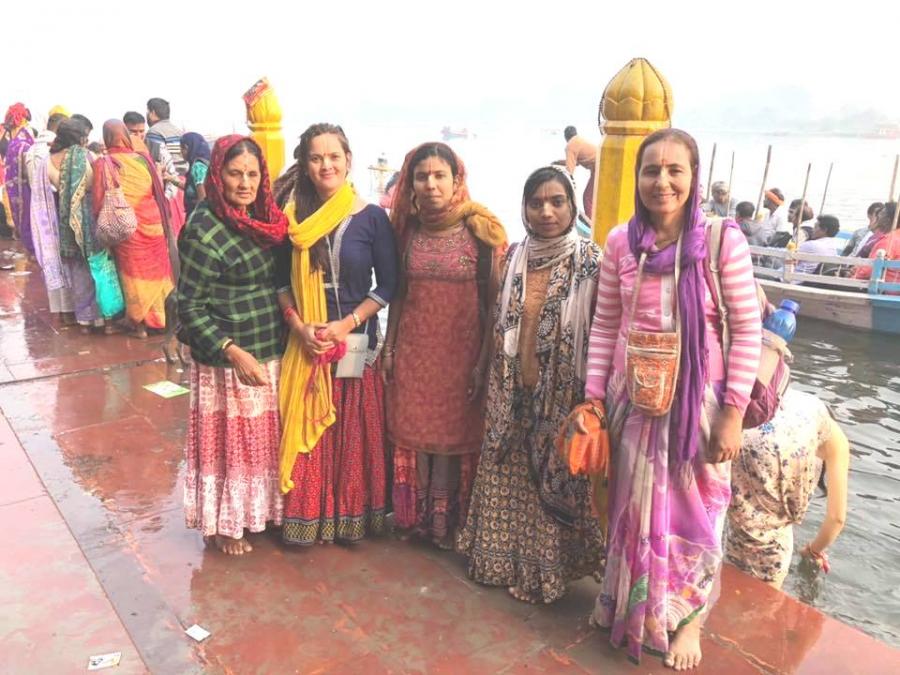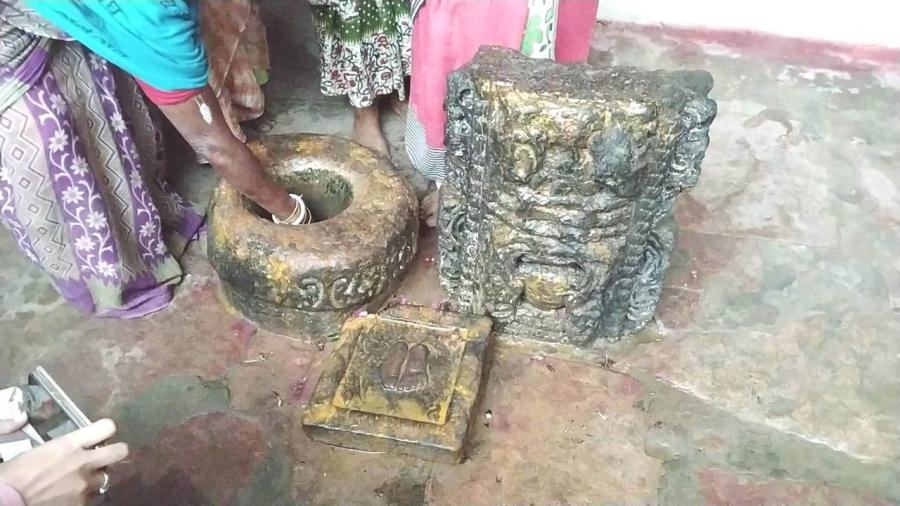by Jayabhadra devi dasi
Just as every year, Karttika 2019 welcomed devotees for the Vraja Mandala Parikrama, the thirty-third year of the month-long walk. About 1800 devotees engaged in parikrama, walking to the places of Lord Krsna’s pastimes in Vrndavana and hearing Radharaman Maharaja and other senior devotees give katha and lectures.
Day 1: 14 October – Vrndavana Parikrama
Along with the deities of Sri Sri Nitai-Gaurasundara and Srila Prabhupada, the Vrndavana Parikrama began after mangala-arati at the Krishna-Balaram Mandir.
The places to be visited today would include Varaha-ghata, where Krsna exhibited His form as Lord Varahadeva for His friends; Kaliya-hrda, a majestic kadamba tree from which Krsna jumped into the river Yamuna for His battle with Kaliya; Dvadasaditya-tila and the Madana-mohana temple, the place of Srila Sanatana Goswami’s samadhi; Imli-tala, where Lord Caitanya would come daily to meditate on the Lord’s intimate pastimes; Srngara-vata and Cira-ghata, where Krsna would dress Himself in various ways to please His friends and where Lord Nityananda stayed during his tour of the holy dhama; and Kesi-ghata, Vamsi-vata, the Jagannatha temple, Pani-ghata, and Caitanya-baithaka, then returning to the Krishna-Balaram Mandir.
In the afternoon local and international devotees, young and old, male and female, the unseasoned and the experienced, all eager to circumambulate the holy dhama (or panca-krosi) while learning of Krsna’s pastimes, gathered for istagoshthi where we were advised of the ten offences to the holy dhama to be avoided on parikrama and instructed to be mentally practising all five items of Maha-Sadhana – sadhu-sanga, nama kirtana, bhagvata-sravana, Mathura-vasa, and sri-murtira shraddhaya sevana.
Day 2: 15 October – Vrndavana to Mathura
Our walk to Mathura started after mangala-arati as we circumambulated the temple led by Nitai-Gaurasundara and Srila Prabhupada, on the way taking darsana of temple deities Sri Sri Radha-Bhataronda-bihari. One morning Krsna asked his friends to go beg food from the brahmanas, who ignored the boys’ request. After returning empty handed Krsna instructed them to beg from the brahmanas’ wives, who rushed to the spot bringing bhat (rice); hence this place is known as Bhataronda.
At Akrura-ghata Akrura had darsana of Krsna-Balarama in the form of Visnu and Sesa Naga. Lord Caitanya also lived at Akrura-ghata for some time when visiting Vrndavana. At Bhagavata Bhavan we took darsana of the large deities of Radha and Krsna, and Jagannatha, Baladeva and Subhadra, and Rama, Laksmana and Sita, and also visited the nearby Potra-kunda where Krsna’s baby clothes were washed. In the evening we went to Krsna-janmasthana, an impressive, heavily guarded structure that towers above all the buildings in Mathura, as well as the Sri Kesavadeva temple.
Day 3: 16 October – Mathura Parikrama
Mathura, the birthplace of Sri Krsna, is one of India’s seven sacred cities, or sapta-puris (or moksa-puris). The other six are Ayodhya, Haridwar, Kasi, Kanci, Ujjain and Dvaraka. The Brahmanda Purana states that “the attainment of ecstatic love for the Supreme Lord … can easily be attained simply by touching the dust of Mathura,” and the Padma Purana “Anyone who spends even one day in Mathura will become devoted to the lotus feet of Sri Hari.”
Our first stop on today’s 14km parikrama was at Gokarna-tirtha. There is a murti of the sage Gokarna in this temple. Four deities of Lord Siva, known as dik-palas, protect Mathura: Lord Siva resides here as Gokarnesvara, Rangesvara, Bhutesvara, and Pippalesvara.
Heading for Visrama-ghata we passed by Cakra-tirtha on the bank of the Yamuna. Across the road is Ambarisa-tila, where Ambarisa Maharaja observed the Ekadasi fast for a year. We then stopped briefly at the Dvarakadhisa temple.
Soon we arrived at Visrama-ghata. Mathura is shaped like a half moon. Along its edge are twenty-five ghatas, twelve on either side of Visrama-ghata, or Visranti-tirtha. Visrama means to rest, and Krsna rested here after killing Kamsa and Lord Varaha rested here after His victory over Hiranyaksa. We all had bath and performed sankalpa for our parikrama.
Overlooking Visrama-ghata we had darsana at a small temple where Yamuna-devi and her brother Yamaraja are worshipped. Once Yamuna devi served Yamaraja such an excellent meal that he promised her he would not judge anybody who bathed in her waters on Yama-dvitiya (Bhaiya Duj) day.
We also visited Pippalesvara Mahadeva, Dhruva-ghata, the Sapta Rsi mandira, the Kubja mandira, the Rangesvara Mahadeva mandira and Rangabhumi, and the Kesavaji Gaudiya Matha established by Bhaktiprajnana Kesava Maharaja, Srila Prabhupada’s godbrother and sannyasa guru. Srila Prabhupada accepted sannyasa here in 1959.
Our day’s adventure drew to a close with visits to Bhutesvara Mahadeva, the Gaura Govinda Gaudiya Matha and the Mahavidya-devi mandira. It was now well into the afternoon and we took rest in a dharmasala. Tomorrow we would leave the paved roads and walk into the more remote parts of Vraja-mandala, farther and farther from the traces of modern life.
Day 4: 17 October – Mathura to Madhuvana
Leaving the early morning bustle of Mathura, the parikrama party soon entered the ancient forest of Madhuvana, the first of the twelve main forests of Vraja we will see on parikrama. Having stopped at Dhruva-tila, where Dhruva Maharaja performed his penance until he entered samadhi, about mid-afternoon the parikramis arrived at the village of Maholi, the site of Krsna-kunda, where we would spend the night.
Day 5: 18 October – Madhuvana to Santanu-kunda
About 5km from Madhuvana we entered the forest of Talavana, the second principal forest of Vraja where Lord Balarama killed Dhenukasura. The local temple is home to beautiful deities of Balarama and His eternal consort, Srimati Revati-devi.
We then continued walking south towards Kumudvana, the third forest of Vraja. Kumuda means “water lily,” and this forest was named because of the bright red lilies that once grew in abundance here. Krsna and Balarama herded their cows and also enjoyed eating lunch in this forest.
We now veered north on to the road leading to the dry and dusty town of Santanu where we visited the temple of Santanu-bihari. The deities of Sri Sri Radha-Santanu-bihari are famous in Vraja for awarding children to childless couples who approach Them for that purpose. Nearby there is a village called Datiha. After He met the Vrajavasis, Krsna came to Datiha from Kuruksetra to kill Dantavakra. We rested by Santanu-kunda and heard Radharaman Maharaja recall how Maharaja Santanu performed austerities here to beget a son who would possess great fame and be able to choose the time of his death. Bhismadeva was that son.
Day 6: 19 October – Santanu-kunda to Radha-kunda
Our destination today was Radha-kunda, and the devotees were ecstatic with anticipation. On hearing the announcements, we called out “Jaya Jaya Sri Radhe Syama.”
Along the way we visited places of the Lord’s pastimes including Khecari (referring to a witch who can fly), the birthplace of Putana who was Ratnamala, the daughter of Bali Maharaja, in her previous birth; the beautiful forest of Mayuravana where Krsna danced with the peacocks (as Lord Caitanya also enjoyed sweet exchanges with the animals, birds and trees in the forests of Vraja); and Bahulavana, the fourth main forest of Vraja where, as stated in the Skanda Purana, Bahula, the wife of Lord Visnu, eternally resides and offers piety to those who visit. Krsna granted Bahula the position of His wife because He was pleased with her honesty as a cow. This pastime coincides with the appearance day of Radha-kunda, which is therefore called Bahulastami.
Finally, we reached the village of Radha-kunda, the dear-most place of Lord Krsna where we would spend the next three nights.
Day 7: 20 October – Govardhana Parikrama
This day was spent visiting the pastimes places lying in the foothills of Giriraja on the ecstatic parikrama of Govardhana, the hill that became the umbrella of the Vrajavasis, with the handle as the left hand of Lord Hari.
We stopped at Kusuma-sarovara, one of the most spectacular lakes in Vraja, where Krsna braided Srimati Radharani’s hair; Narada-kunda, in the small forest where Narada Muni wrote the Narada-bhakti-sutras; Syamavana and Ratna-simhasana, a jewelled throne on which Srimati Radharani would sit while enjoying Her pastimes in this forest; Manasi-ganga, where having killed Vatsasura, Krsna’s friends teased Him for killing a calf and advised Him to atone by taking a dip in the holy Ganga. For their pleasure Krsna manifested the Ganga from His mind (mana) and then bathed in her waters.
We also visited the temple of Harideva, one of Vraja’s four main deities; Brahma-kunda; Dana-ghata; the ISKCON Bhaktivedanta Ashram; Aniyora; and Govinda-kunda, formed when Indra bathed Krsna with milk, Ganges water, tulasi-manjaris and lotus flowers after Krsna had set down Govardhana Hill.
By now we were at the southernmost tip of Govardhana that is guarded by Punchari ka Lautha-baba, Krsna’s well-built friend who is still waiting for the Lord to return from Mathura, then retracing our steps to the interior parikrama path we came to the cave of Raghava Pandita-gupha, and then Kadambavana, Jatipura, Mukharavinda and Sakhisthali, all enriching our parikrama experience. Towards the end of the parikrama path we rested at Uddhava-kunda, where after realizing the exalted nature of the gopis’ love for Krsna, Uddhava prayed ardently to live eternally in Vraja as a clump of grass.
Our last stop before the village of Radha-kunda was at the Radha-kunjabihari Gaudiya Matha, founded in 1935 by Sril Bhaktisiddhanta Sarasvati Thakur. And then at long last we beheld the splendid Sri Sri Radha-kunda and Syama-kunda. Tomorrow we would visit all the special places surrounding these sacred waters.
Day 8: 21 October – Radha-kunda Parikrama and Bahulastami Utsav
Today we did parikrama of Sri Radha-kunda, the topmost holy place in the universe. We also celebrated Bahulastami, the appearance day of Sri Radha-kunda. As Lokanath Maharaja has explained, Radha and Krsna are one soul in two forms – those who have transcendental eyes can see Radha-kunda as the scriptures describe it.
There are many important sthalis around Radha-kunda including Kundesvara Mahadeva, one of the four Shiva deities who protects Sri Radha-kunda; the Gopinatha temple and Raghunatha dasa Goswami’s samadhi, where Srila Raghunatha dasa did bhajana for forty years and after he entered Nitya Lila was given samadhi. It is he who got Sri Radha-kunda renovated and beautified; and Janhava Mata Baithaka on the bank of Sri Radha-kunda, the sitting place of Janhava Mata, the eternal consort of Lord Nityananda who took the responsibility of preaching after His disappearance.
There are also the bhajana-kutiras of Srila Gopala Bhatta Goswami, Srila Raghunatha dasa Goswami, Srila Visvanatha Cakravarty Thakur, Srila Krsnadasa Kaviraja Goswami, Srila Bhaktivinoda Thakur, Srila Bhaktisiddhanta Sarasvati Thakur, and Jiva Goswami.
At midnight we celebrated the Radha-kunda appearance day festival by taking bath in that most auspicious of holy places.
Day 9: 22 October – Radha-kunda to Dig
We followed the Govardhana Parikrama road until Govardhana town, where at the entrance we turned right and walked a short distance before turning left towards the area known as Cakra tirtha on the north bank of Manasi-ganga. Here we found the temple of Cakresvara Mahadeva, who is one of the four ksetra-palas, or forms of Lord Shiva who protect Vraja-mandala. We offered him our humble respects. Next to the temple is Sanatana Goswami’s bhajana-kutira, from where the elderly saint would daily perform the 40km (exterior) Govardhana Parikrama.
After walking another 3km we entered Ganthuli-gram. Ganthuli means “knot.” The Bhakti-ratnakara states that once, while celebrating Holi here, the sakhis secretly tied Radha’s cloth to Krsna’s as They sat on Their simhasana. Gulal-kunda, which is located just before the entrance to Ganthuli-gram, was given this name because its water turned pink from the colours being thrown around during Holi. Ahead on the Govardhana-Dig road is Bahaj, formerly known as Reheja. Here, a remorseful Indra approached Krsna, accompanied by Surabhi cow.
Day 10: 23 October – Dig to Badrinatha
Early in the morning we started from Dig to Badrinatha, a 17km walk. About 5km from Dig we came to Didavali, said to be the place of Krsna’s maternal grandmother, Variyasi-devi. After passing through the village of Khoh we steadily climbed a steep rocky area and then descended into a sparsely populated valley, stopping for some time near a lake surrounded by a grove of kadamba trees known as Kadamba Kanana where, it is said, that Krsna performed a rasa-lila with ladies of the Pulinda caste.
We reached Badrinatha, or Adi-Badri, in the afternoon. Just as Krsna is the source of all incarnations, so Vraja-dhama is the origin of all holy places. Therefore, the Badrinatha found in the Himalayas is an expansion of the Badrinatha found in Vraja – hence the name Adi-Badri. There is a beautiful deity of Nara-Narayana Rsi, the Lord’s fourth incarnation, in the temple at Badrinatha. Village life here centres around Tapasya-kunda, also known as Sitala-kunda for its cool waters. This remote place is untouched by the advancement of the so-called modern age and it provides an experience of the Lord’s beautiful creation.
Day 11: 24 October – Badrinatha Parikrama
Our circumambulation of Badrinatha-dhama began with an early morning climb up the steep slopes of Narayana Parvata. At the mountain top we took in the natural beauty of the place, then climbed down the other side into the valley. Adi-Badri is, of course, on a much smaller scale than the Himalayan Badrinatha. Eventually we came to Laksmana-jhula, nestled between two mountains, where Laksmana performed austerities. From here we can see the dried-up riverbeds of the Ganga and Sarasvati, both of which meet at the place known as Triveni sangam. There is also a lake, some distance away, called Deva-sarovara. While wandering through the forests Radha and Krsna came to Deva-sarovara and sat on its shore. The last place we visited before returning to the Nara-Narayana temple was the Yogamaya mandira. In the Bhagavad-gita (7.25) the Lord says that He is yoga-maya-samavrtah, “covered by His internal potency.”
Day 12: 25 October – Badrinatha to Kamyavana via Kedarnatha
Near Badarikasrama in the Himalayas is Lord Shiva’s abode, Kedarnatha. After taking His family to Adi-Badri, Krsna led them to Kedarnatha in Vraja. It would be a long walk so we started early. Having trekked along the boundaries of cultivated fields and through an ocean of elephant grass, we suddenly saw mountains before us and high above our heads the temple of Kedarnatha. We climbed the 270 steps cut into the mountainside to reach the temple and crawling inside what is actually a natural cave, paid our respects to the self-manifested Siva-linga.
After another long walk we entered the forest of Kamyavana, the sixth main forest of Vraja, and arrived at Carana-pahadi, the place where Lord Krsna used to play His flute and the stones underneath His lotus feet would melt with the sound. The view from the summit of Carana-pahadi is of a beautiful green plain where Krsna and Balarama herded Their cows. Proceeding to our campsite at Kaman village we visited Gaya-kunda, where Nanda Baba did Shradha Tarpan for his ancestors.
Day 13: 26 October – Kamyavana Interior Parikrama
There is so much to see in Kamyvana that we spent two days here. We visited the Radha-Gopinatha temple followed by Caurasi Khambha, a palace of eighty-four pillars built by Visvakarma, the architect of the demigods, in one night for the Pandavas when they were in exile. We then stopped at the Madana-mohana temple, the Radha-Govindadeva and Vrnda-devi temple, the Kamesvara Mahadeva temple, the Panca-pandava temple and Dharma-kunda, Vimala-kunda, Yasoda-kunda, and finally Setubandha Ramesvaram, Lanka and Asoka Vatika. Setu means “bridge” and it was here that Krsna exhibited Lord Ramacandra’s pastime by building a bridge across a lake to “Lanka” for the gopis, the remains of which are still visible.
Day 14: 27 October – Kamyavana Exterior Parikrama
After mangala-arati we left Kaman village and walked the 2km to Surabhi-kunda, so named because many of Krsna’s cow herding pastimes took place in the area and the cows came here to drink water. Overlooking the kunda is the bhajana-kutira of Srila Prabodhananda Sarasvati Thakur, the spiritual master of Srila Gopala Bhatta Goswami. Further on we came to Phisalini-sila, where Krsna and the cowherd boys enjoyed sliding down the smooth surface of a large rock while the cows grazed. We then went around the hill to see the demon Vyomasura’s cave, where he kept Krsna’s friends that he had kidnapped (until killed by Krsna in an airborne battle), and then proceeded to Bhojana Sthali where Krsna ate lunch with His friends. We took part in this pastime by honouring breakfast prasad here.
Day 15: 28 October – Kamyavana to Varsana
By now it was getting cold and we all took to wearing warm clothes in the early morning. On the way to Varsana we visited the villages of some of the dear-most sakhis of Radharani. Our first stop was Kanvara, where Yasoda Maiya brought Krsna to get His ears and nose pierced, a common practice in India.
Across a red hill about 3km from Kanvara is Kadamba-khandi. Except for a pass through the surrounding mountains this place is inaccessible from three sides, so Krsna chose it for His meetings with Radharani. The Lord also enjoyed the rasa-lila with the gopis here.
As the honeycomb is surrounded by the honey bee, Varsana-dhama is surrounded by the villages of the eight principal sakhis. Just 2km from Kadamba-khandi is Sunhara-grama, home of the twin sisters Sudevi and Rangadevi.
Further along we passed through a thorny patch and climbed a rocky knoll. This hill is known as Sakhi-giri-parvata because all of Srimati Radharani’s intimate friends would play together here. We also saw Citra-vicitra-sila, a smooth rock with the leaf patterns of Srimate Radharani’s veil impressed on it, and Sikhalini-sila where Krsna and the cowherd girls celebrated the Holi festival, the red colour spilled on the rocks still visible after 5000 years.
We then retraced our steps to the Varsana road and then on to the path to Uncagaon (Lalita-grama), the birthplace of Lalita Sakhi, the most prominent of the astasakhis. In her temple Lalita Sakhi stands beside Sri Sri Radha-Lalitanatha contemplating how to enhance Their loving ecstasies.
As we entered the day’s destination, Varsana, we offered our obeisances to the holy abode of Srimati Radharani.
Day 16: 29 October – Govardhana Puja and Varsana-dhama
After morning class, we performed go-puja. In keeping with the Lord’s instructions, in addition to worshipping Govardhana Hill we also honour the cows on this day. After offering obeisances to a cow and her calf we took turns feeding them, performed an arati to them along with a kirtana, and then circumambulated them. A short time later the devotees gathered to worship Govardhana Hill in the presence of Lokanath Maharaja, Sacinandanan Maharaja, Radharaman Maharaja, and other senior devotees.
Following Govardhana Puja, at 3pm we began Varsana Parikrama. The 6km parikrama path took us through some of the most enchanting pastimes places of the Lord and His eternal consort. We visited Sankhari-khor, the narrow pass Srimati Radharani and Her friends would use on their way to the Varsana market in the hope of meeting Krsna; Ciksauli-grama, the birthplace of Citra Sakhi, the fourth of the eight principal gopis who according to the Padma Purana created the nearby pond of Mayura-sarovara; the forested area of Gahvarvana, where at the foot of Mor-kutira Hill is Krsna-kunda; Mor-kutira, the “temple of the peacocks”; Mana-garh, another of Varsana’s hills at the top of which is the Mana-kutira temple; and Dana-garh, where we had darsana of Sri Sri Radha-Dana-bihari. We also had darsana of the deities at the Radha-Kusala-bihari mandira, and then at the Ladali-Lala temple atop Varsana’s northernmost peak.
Day 17: 30 October – Varsana to Nandagrama
Following an early morning initiation ceremony by Lokanath Maharaja at Varsana-dhama the parikramis pulled up their tents and packed their luggage into the truck. Today’s walk will be fairly short, just 8km to Nandagrama. Our first stop was Prema-sarovara, where a pastime between Srimate Radharani and Krsna took place in relation to a bumblebee that had flown into the whorl of a lotus flower adorning Srimati Radhika’s ear. Madhumangala, who was also present, chased it away and declared “Madhu is gone.” Madhu means “bee,” but when Radharani heard this She took it to mean Her Madhusudana, and the thought of separation caused Her to lose consciousness.
Midway between Nandisvara Hill and Vrsabhanu Hill is Sanketa, the place of Radha-Krsna’s rendezvous. Sanketa means “to indicate,” and while together in the company of others Radha and Krsna indicated to one another through body language the location of Their next meeting place. Next to the Sanketa-devi temple is the bhajana-kutira of Srila Gopala Bhatta Goswami who spent a significant amount of time in this place.
We then passed through Uddhava-kyari, where Uddhava met the gopis when he came to deliver Krsna’s message that He would return to Vrndavana as soon as He had finished His business in Mathura. We also visited Nanda Baithaka, where Nanda Maharaja met his brothers to discuss important issues, and then Yasoda-kunda and Hau-bilau, where Mother Yasoda used to bathe and where she once told Krsna and Balarama They would be kidnapped by the hau (or bogeyman) if They continued to ignore her calls to come home. Lastly, we visited the Narasimha-Varaha temple.
Upon our arrival in Nandagrama we stopped first at the Krsna-Balarama temple and then at the Nandisvara Mahadeva temple in the courtyard of Nanda Maharaja’s palace, where Lord Siva was denied darsana of baby Krsna by Mother Yasoda who thought his ash-covered body would frighten her child. At Pavana-sarovara, the place of Sanatana Goswami’s bhajana-kutira, we would camp overnight.
Day 18: 31 October – Srila Prabhupada’s disappearance day
On this day the annual Vraja-mandala Parikrama schedules a visit to Khadiravana, the seventh of Vrndavana’s twelve forests, where Krsna and His cowherd friends used to play while tending the cows. We visited the place in Khadiravana where it is said Krsna killed Bakasura, and also went to Lokanatha Goswami’s bhajana-kutira on the bank of Sangama-kunda where Krsna and the gopis used to meet.
By mid-morning we had travelled by bus to join the devotees at the Krishna-Balaram Mandir for the observance of Srila Prabhupada’s disappearance day. Srila Prabhupada revealed Vrndavana-dhama to the whole world. Before meeting Srila Prabhupada most of us didn’t even hear the name Vrndavana, what to speak of knowing its glories. Following in the footsteps of the Six Goswamis, Srila Prabhupada showed by his own example the ideal behaviour of a Vrajavasi. Srila Prabhupada, ki jai!
Day 19: 1 November – Nandagrama to Kokilavana
Two kilometres east of Nandagrama we came to the Asesvara Mahadeva temple. Asa means “desire,” and it is here that Shiva’s heartfelt desire to see Krsna was eventually fulfilled. Having offered our respects to Asesvara-kunda we then entered the small forest of Ter Kadamba, where it is said that Krsna brought His cows to graze and often sat under a kadamba tree to play His flute and call the cows back when it was time to go home.
We then arrived at the populous town of Javata, the home of Srimati Radharani’s in-laws after She married Abhimanyu. Krsna always tried to meet His beloved here and to accomplish that employed all His tricks and disguises. After breakfast at Javata we made our way to Kokilavana. Kokila means “cuckoo,” and it was in this forest that Krsna imitated the shrill notes of a cuckoo. The kokilas responded so loudly that the sound was heard in Javata. The gopis then sought permission from Srimati Radharani’s mother-in-law to go and see the kokilas, and in this way Radharani and Her sakhis were able to meet Krsna here. We visited the temple of Sri Sri Radha-Kokilavana-bihari before settling for the night.
Day 20: 2 November – Kokilavana to Sesasayi
About 2km from Kokilavana we passed Bathain, where Nanda Maharaja would meet the cowherd men and Sanatana Goswami would often spend time. Walking another kilometre, we came to Carana-pahadi and saw footprints of Krsna and His cows melted into the rocks. After crossing the busy National Highway 2 we reached the forest of Kotvana, where the Lord enjoyed His blissful pastimes. Eventually we came to the peaceful village of Sesasayi, the location of Ksira-sagara-kunda, the Milk Ocean in Vraja. It was here that Krsna transformed Himself into Lord Narayana and lay down on Balarama, who became Ananta Sesa. Srimati Radharani then massaged Krsna’s lotus feet, and in this way the Lord displayed His Vaikuntha mood in Vraja.
Day 21: 3 November – Sesasayi to Shergarh
With an 11km walk in front of us to Shergarh our parikrama party soon passed through Payagrama, where Krsna is said to have drunk milk with His friends. Paya means “milk” and one day while Krsna and Balarama and the cowherd boys were herding their cows, the boys became very hungry. Since their lunch had not yet arrived, they milked their own cows and drank the milk. Eventually we arrived at Shergarh where we would spend the night. Shergarh was given this name because it is said to have been the village of Shekhar Gopa, one of Krsna’s cowherd friends.
Day 22: 4 November – Shergarh to Cira-ghata
Groves of bushes, trees, and colourful flowers line the way to Rama-ghata, where Lord Balarama performed His rasa dance. It was then quite a long walk to Viharavana. Vihara means “to wander,” and Krsna loved to wander in this forest, one of His favourite playgrounds. As we progressed through the fields, we came to Aksaya-vata (eternal banyan tree) under the branches of which Krsna ate lunch and enjoyed wrestling games. Just 1km ahead on the bank of the Yamuna was Tapovana, where the gopis performed their austerities to get Krsna as their husband. The presiding deities here are Sri Sri Radha-Gunjabihari, named after the auspicious gunja plant.
Skirting the Yamuna’s sandy bank our party eventually arrived at Cira-ghata, where Krsna stole the unmarried gopis’ garments, fulfilling their desire to have Him as their husband, for a woman cannot be unclothed before any man but her husband. Srila Jiva Goswami in the Gopala-campu states that “Krsna stole their cloth and their hearts, and returned only their cloth. He did not return their hearts, but hid them.” The pastime took place on the day the gopis completed their month-long vow of worshipping Katyayani-devi. The parikrama party spent the night camped behind the Katyayani temple.
Day 23: 5 November – Cira-ghata to Mat
We now had just over a week left of parikrama ahead. We’d already had darsana of the seven forests (including Vrndavana) located to the west of the Yamuna, over which Krsna presides. Today we would cross the Yamuna and start passing through the remaining five principle forests of Vraja located to the east of the river, over which Balarama presides.
About 3km from Cira-ghata was Nanda-ghata, where a large, fatherly deity of Nanda Maharaja looks over the sandbank where the Yamuna once flowed with Mother Yasoda next to him. The sand felt warm under our feet as we crossed the old riverbed towards the Yamuna where a number of boatmen were waiting to ferry us to the east bank in their wooden boats.
We were then immediately in the Bhadravana forest, the eighth of Vraja’s forests where it is said that Krsna killed Vatsasura. Walking a further 2km along a paved road we got to Bhandiravana, Vraja’s ninth forest. Many amazing pastimes took place here, but the special feature of Bhandiravana forest is its gigantic banyan tree, Bhandira-vata, under which, long before Her marriage to Abhimanyu, Sri Radha married Lord Krsna in a ceremony performed by Brahma. Many people come here simply to remember that occasion.
Not far from Bhandira-vata is the Sri Sri Radha-Ananda-bihari temple, in front of which is a well, Venu-kupa, said to have been created when Krsna pushed His flute into the ground. About 300m ahead is another sacred banyan known as Vamsi-vata and a temple dedicated to Krsna’s friend, Sadama. From here we made our way to Mat, today’s destination.
Day 24: 6 November – Mat to Mana-sarovara
A few kilometres south of Mat we left the main road and headed for Laksmi-devi’s temple on the bank of the Yamuna in the Bilvavana forest, the tenth of Vraja’s main forests. The forest is also known as Srivana, because this is where Laksmi-devi lives, performing austerities to gain entrance into the Lord’s rasa-lila.
After walking through very marshy terrain we came to Mana-sarovara. It is here that Srimati Radharani expresses Her transcendental anger (“mana”) and Krsna begs Her to give up Her anger towards Him, speaking the following famous verse:
smara-garala-khandanam mama sirasi mandanam
dehi pada-pallavam udaram
O Radhe! Your lotus feet will fulfil all My desires. So kindly place Them on My head! I’m burning in the flames of Kamadeva’s bonfire. O please relieve My suffering by the touch of Your cooling lotus feet. (Gita Govinda, 10.8)
Day 25: 7 November – Mana-sarovara to Lohavana
Now that we were nearing the end of Vraja-mandala Parikrama we began feeling separation from Vrndavana. About 5km into today’s walk we came to Pani-gaon, the village where Durvasa Muni, Lord Krsna’s spiritual master, stayed for some time. Durvasa means “one who drinks the juice of the durva grass” – Durvasa never ate anything, having vowed to drink only this juice.
We then headed for Lohavana, the eleventh of Vraja’s forests, named after the Lohajanghasura demon who was killed here by Krsna. We had darsana of the beautiful Sri Sri Radha-Gopinatha and were then taken behind the temple to Krsna-kunda and shown Lohajanghasura’s cave, about 15m from Krsna-kunda and the Radha-Gopinatha temple. Lohavana was also the battlefield where Jarasandha was defeated seventeen times by Krsna and Balarama.
Lohavana is quite remote and unfrequented and after we left the Radha-Gopinatha temple we saw mainly agricultural land bordered by trees, eventually setting up camp in the middle of fields.
Day 26: 8 November – Lohavana to Dauji
Today was Utthana Ekadasi, which refers to the waking of Lord Visnu in the ksira-sagara ocean having slept for four months, so according to the Ekadasi system Caturmasya ends today, but by another calculation it ends on Karttika-purnima. During Caturmasya it is recommended for devotees to spend time hearing and chanting in the holy dhama. Today was also the disappearance day of Srila Gaura Kisora dasa Babaji and the first day of bhishma-pancaka, the last five days of Karttika, when devotees perform additional austerities to please the Lord. The Hari-bhakti-vilasa states that the Lord Himself gave these five days to Bhismadeva for fasting, and it is therefore named after him. This would be one of the longest walks of our parikrama and it was still dark when we set out for Dauji.
We arrived at Bandi-Anandi by mid-morning. The temple is dedicated to Yogamaya-devi and here we had darsana of Bandi-devi and Anandi-devi, who represent two aspects of Krsna’s yogamaya sakti. His potency that caused the jail to be unlocked and Vasudeva’s shackles to fall was Bandi-devi. Anandi-devi put the guards and the cowherd men to sleep, so by her potency Vasudeva carried Krsna to Gokula undetected. Behind the temple is Bandi-Anandi-kunda. Quickly covering the remaining 4km to Dauji, we entered Mahavana, the last of Vraja’s principal twelve forests, on the way.
Dauji, known locally as Baladeva, is a bustling town where life revolves around the Dauji mandira, in which the largest deity of Balarama in Vraja is worshipped. Dauji is an affectionate term meaning “older brother.” The deity is one of the four principle deities of Vraja installed by Vajranabha, Krsna’s great-grandson (the others being Kesavadeva, Harideva and Govindadeva), and the only one still in Vraja.
Day 27: 9 November – Dauji to Brahmanda-ghata
Today we began walking back towards Mathura, our day’s destination being Brahmanda-ghata. Our first stop was at Cintaharana-ghata, the place where Mother Yasoda worshipped Lord Siva to become free from her anxiety concerning her son’s welfare. Cinta means “anxiety” and harana “to take away.” In his role as ksetra-pala it was Lord Siva’s responsibility to keep undesired elements out of Vraja, therefore it was natural for Mother Yasoda to approach Lord Siva to keep her son safe. There’s a temple of Lord Siva here where we had darsana of Cintaharana Mahadeva, as Siva is called.
Later in the morning we arrived at Brahmanda-ghata where we would make camp. Brahmanda-ghata is a part of Nanda Maharaja’s courtyard. As infants Krsna and Balarama and the other cowherd children came here to play. One day, Balarama and the cowherd boys complained to Mother Yasoda that Krsna had eaten dirt. However, when she questioned Him, Krsna denied the charge, saying, “Mother, if you think they are speaking the truth, then look into My mouth and see for yourself.” Mother Yasoda saw in her son’s mouth the entire cosmic manifestation, which includes the universe (brahmanda). That’s why this place is known as Brahmanda-ghata.
Today was parikrama commander Brajabhumi prabhu’s birthday and we all wished him a very Krsna conscious birthday.
Day 28: 10 November – Brahmanda-ghata
Every year this day at Brahmanda-ghata is dedicated to sharing realisations about parikrama.
Devotee: “Vraja-mandala Parikrama is the perfect test of one’s spiritual health. In the pure atmosphere of the dhama, our anarthas stand out like black spots on a white sheet. Any dirt of material desire becomes instantly apparent.”
Devotee: “I’m learning how to be more tolerant, sensitive, kind and polite with others.”
Devotee: “Throughout the parikrama we have felt like we are part of a big family. ISKCON devotees have a special affinity for this place because Srila Prabhupada bathed at Brahmanda-ghata with his disciples.”
Devotee: “Because of devotee association you don’t experience the full extent of the inconveniences on parikrama. At home it is difficult to get up for mangala-arati, but on parikrama it’s easy. I intend to maintain this habit after I return home. Here Vrajavasis welcome you into their homes, make you sit down, feed you, and treat you like one of their family members. Austerities are necessary so that our false egos are vanquished. One should come to the dhama, roll in the dust, leave our false ego there, and go out begging for mercy.”
Devotee: “It was a wonderful experience. We got nice facilities like home and lots of love and association of devotees. We went to many places where the Lord performed his lilas.”
Rupali mataji from Kolhapur: “It was my first experience in parikrama. I was thinking that I would not be able to walk, but now I have joined I have to walk and as I saw everyone is walking, so I also walked with their help. All credit goes to all of you. Istadeva prabhu helps everyone a lot. He understands everyone and deals with everyone nicely.”
Chandra Mukhi mataji from Beed: “I was thinking, how will I walk? I am suffering with diseases; how will I manage? But as I saw devotees running, flying like a flag high in air, inspiring me – at first, I used to walk with slippers but was so often removing them, walking without footwear. It’s all due to our Gurudeva, Lokanath Maharaja, who started this parikrama. It’s all his mercy. I am thanking him and all the management devotees.”
Devotee: “Nice sadhu-sanga. So many sannyasis came here for darsana and katha and doctor seva. Very nice.”
Devotee: “Maharaja’s book is very nice. I read it but not fully, so next time I will read it nicely and experience the bliss of Vraja nicely. Katha of Radharaman Maharaja is like nectar, and since morning we are engaged in Krsna-sravana and kirtana.”
Day 29: 11 November – Brahmanda-ghata to Raval
Today our destination was Raval, Srimati Radharani’s birthplace. Our first stop, however, was in Gokula, about half a kilometre from Brahmanda-ghata, both places being inside Nanda Maharaja’s courtyard where his community stayed until Krsna was three years and four months old. Our path, therefore, took us through the very area where the Lord played as a child. We saw Ukhala-bandhana (Yamalarjuna-bhanjana-tirtha), where Mother Yasoda tied Krsna to a grinding mortar and He accepted it as great fun; Nanda Maharaja’s cowshed, the place where Garga Muni secretly performed Krsna and Balarama’s name-giving ceremony; Sapta-samudra-kupa, Nanda Maharaja’s well that contains water from the seven oceans of the universe; Nanda Bhavan, Nanda Maharaja’s grand palace that was the Lord’s home; and Sanatana Goswami’s bhajana-kutira.
About a kilometre from Gokula we came to Ramana-reti, which literally means “pleasure-giving sands” and Krsna and Balarama had great fun playing in this terrain. Here we rolled in the very fine sand, which has been touched by the lotus feet of Krsna and Balarama. Raval, formerly known as Mukhyeravali, was now only a few kilometres away along the busy Mathura-Gokula road.
About midday we arrived at Raval, the transcendental appearance place of Srimati Radharani. The Ladali-Lala temple, Raval’s main feature, is in a pleasant but secluded spot near the Yamuna and we had to cross several thorny patches as we wound our way through high grass and fields. At the temple we had sublime darsana of Sri Sri Ladali-Lala, and then took rest at our camp close by. In the afternoon, before our later-than-normal lunch prasada, we gathered in a small garden next to the temple to hear about Srimati Radharani’s appearance and glories from Sridhara Maharaja.
In Kali-yuga, hearing is most important. At the time of Radharani’s appearance the Yamuna flowed nearby the palace of King Vrsabhanu. One morning around sunrise Vrsabhanu saw something light in the river. Thinking it to be a padma flower he went to the river bank and saw a lotus, upon which there was a baby resting. It was Srimate Radharani. Vrsabhanu took Her to his palace, but to everyone’s dismay Her eyes were closed and She was thought to be blind. However, before Her auspicious appearance Radharani had vowed that She should first have darsana of Krsna, and only after that would She open Her eyes.
On the third day following Vrsabhanu’s discovery Narada Muni came and told Vrsabhanu he would like darsana of his baby. Vrsabhanu was surprised and told Narada that She was blind. But Narada knew who She was and said, “This cannot happen – now let me see.”
Narada said to Vrsabhanu, “Go to Nandagaon and tell all the Vrajavasis to make bhoga and collect water from the holy tirtha.” Narada prayed to Radharani: “Oh Maiya, please give me darsana.” Radharani then gave darsana to Narada Muni, just as Krsna had given darsana to Devaki and Vasudeva in Mathura.
Baby Krsna was now brought close to Radharani. He touched Her and Radharani opened Her eyes, thus first had darsana of Krsna.
Day 30: 12 November – Raval to Mathura
This was our last day in parikrama, our last walk in Vraja. We walked, but our speed was slow as our hearts were heavy with the pain of leaving the dhama and devotees. After bathing in the Yamuna and completing our sankalpa of one-month parikrama, we sat in the bus bound for Vrndavana.
A great welcome was waiting for us at the Vrndavana gosala. Each one of us was garlanded and our foreheads decorated with cool candana. We then entered the Krishna-Balaram Mandir compound through the front gate with a roaring kirtana. In the temple room we took darsana of Sr Sri Gaura-Nitai, Sri Sri Krsna-Balarama, and Sri Sri Radha-Syamasundara. Then we went to the gosala where we were offered a sumptuous feast.
After prasada we collected our luggage, and going our separate ways bade each other farewell.
A fortunate soul completes his parikrama
Just like last year, we had a dog walking with us from Mathura to Mathura. Devotees started noticing the dog but thought it was just like every other dog, but as the days passed it was confirmed that he was one of us. At arati time the dog would come and rest in the pandal somewhere. He would eat the left-over prasad and would always be around devotees. He would be ready on the road and follow as Sri Sri Nitai-Gaurasundara went ahead. When another dog attacked him all the devotees ran to save him. The devotees would cover him with a blanket as winter was approaching. Somebody would say “Hare Krsna prabhuji” to him and he would look at that person with love. Someone would put a garland around his neck and say to him, “Oh dear, you are so fortunate.” Thus, after thirty days and the walk had ended in Mathura’s Visrama-ghata, when we moved towards Vrndavana our parikrama dog stayed back. It was very inspiring to see the dog daily. He did not bite anyone and we never heard him barking at a devotee.

